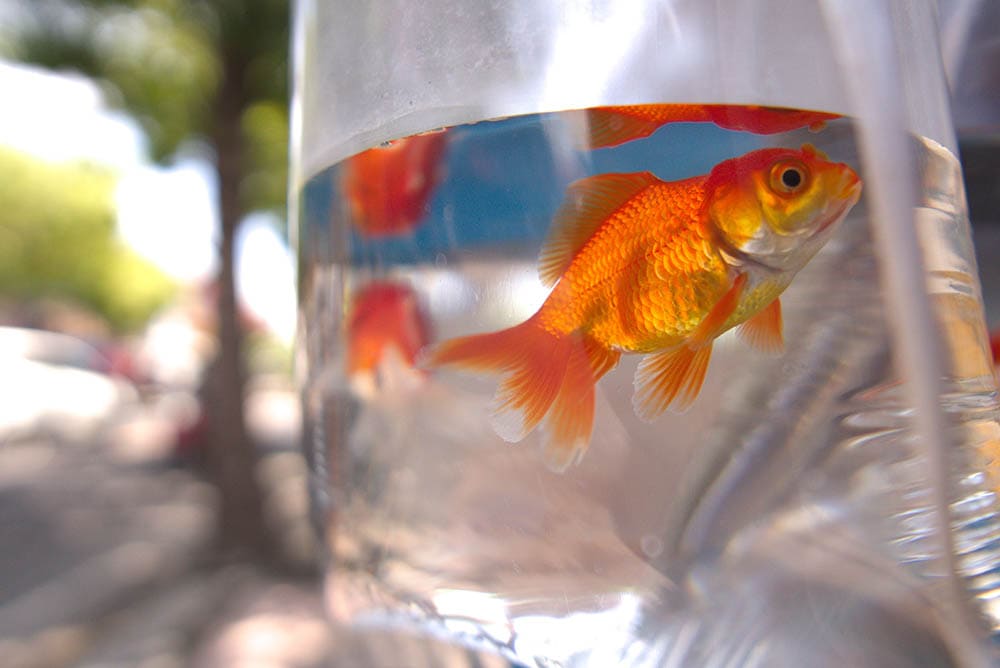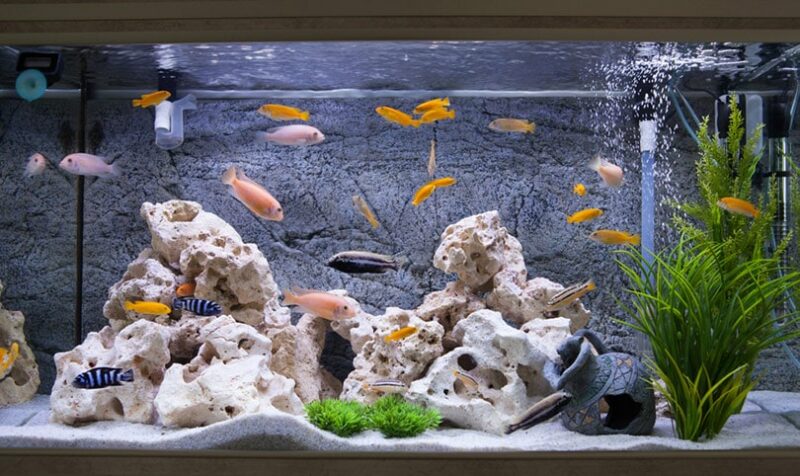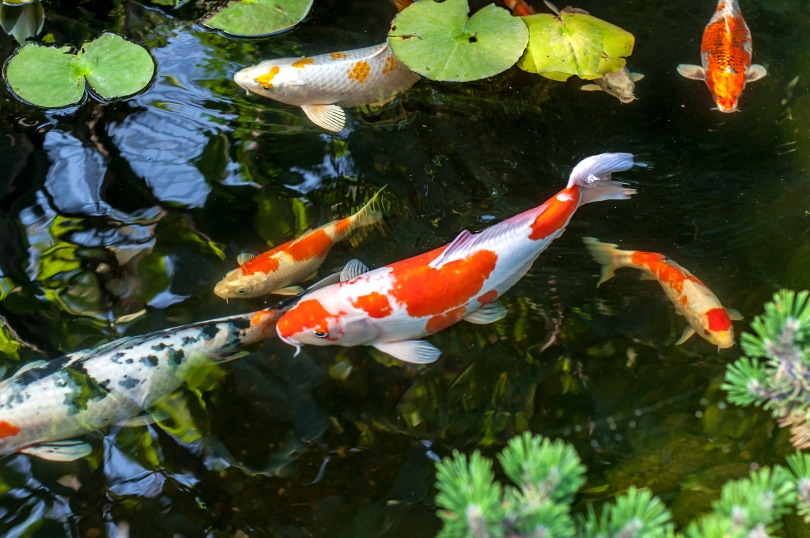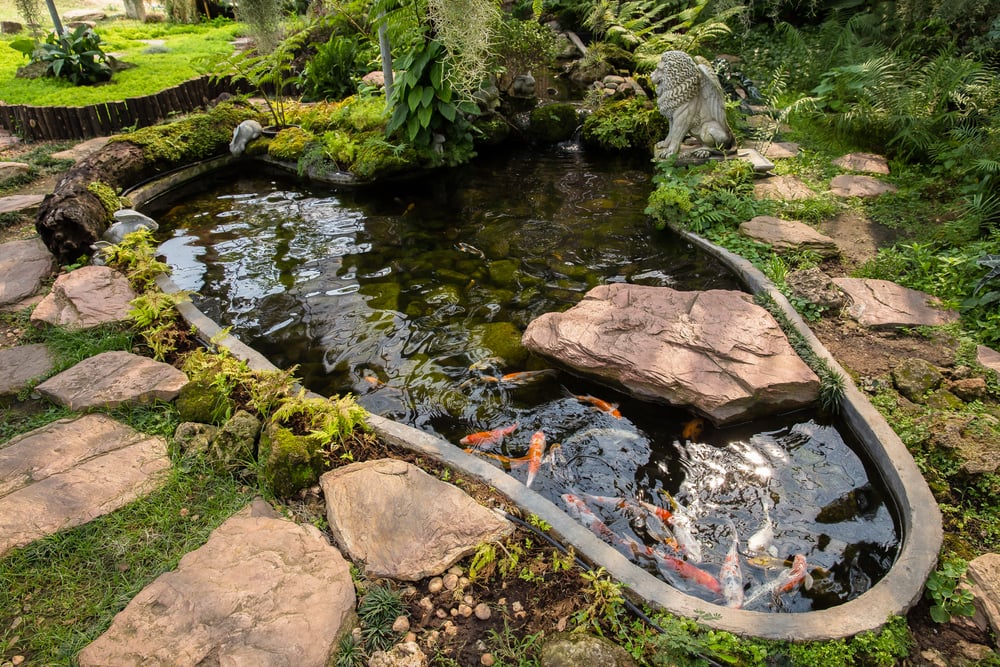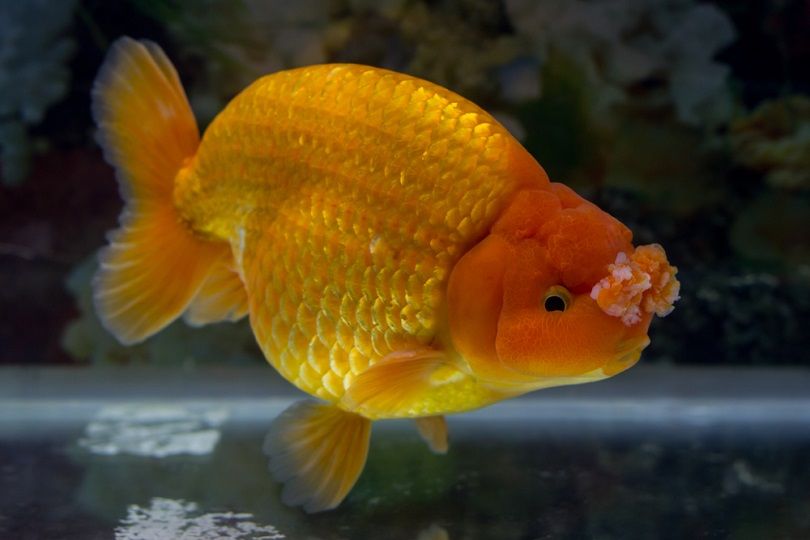
The Pompom Goldfish comes by its name honestly thanks to the fleshy decorative growths on its forehead. These goldfish are instantly recognizable by enthusiasts due to this distinguishing marking.
If you have a tank of docile swimmers and no snagging aquarium decorations, this fish can make a charming addition to your gorgeous setup.
Quick Facts about Pompom Goldfish
| Species Name: | Hana Fusa |
| Family: | Cyprinidae |
| Care Level: | Moderate |
| Temperature: | 65-80 degrees Fahrenheit |
| Temperament: | Social, docile |
| Color Form: | Orange, yellow, black, white, blue, silver |
| Lifespan: | 10-15 years |
| Size: | 4-6 inches |
| Diet: | Omnivorous |
| Minimum Tank Size: | 20 gallons |
| Tank Set-Up: | Freshwater |
| Compatibility: | Slow-swimmers, docile fish |
Pompom Goldfish Overview
Pompom Goldfish are a variation of the traditional goldfish, bred to have lovely, fluffy-looking growth portions on the forehead area. These fish can be a spectrum of beautiful colors, adding personality to the tank.
Because these fish are so at-their-own-pace, they do best in relaxed tank settings. They enjoy the company of calm fish and tend to be very social and friendly with tank mates.
These fish are not only modest and easygoing, they are quite the sight to behold. Their unique appearance and flowing fins add charm to any setup—permitting all the fish can get along, of course.
Surprisingly, the Pompom isn’t a new fad in goldfish breeding, rather this type of fancy fish dates all the way back to the 1800s. They didn’t gain immense popularity until the 1930s when they began to transport these beautiful fish from China to other countries.
How Much Do Pompom Goldfish Cost?
Even special breeds of goldfish like the Pompom are generally inexpensive. They thrive for years under the right care circumstances as well, so they quickly pay for themselves.
While prices can vary depending on purchasing, the cost generally falls between $15 and $30. This is a high price tag for a goldfish but still falls in a relatively budget-friendly category for most aquarists.
Even though this type of goldfish was once wildly popular, their numbers and availability have decreased. So even though you can probably locate an aquarist who has some on hand, it might be a challenge.
Typical Behavior & Temperament
Pompom Goldfish are incredibly docile, not faring well with more aggressive or faster-swimming fish. They require a habitat that allows them to leisurely swim around the tank without feeling rushed, anxious, or in competition for food.
It’s important to note that streamlined goldfish and fancy goldfish are different in terms of temperament. Because streamlined goldfish are generally more active, they can easily (and do) bully fancy goldfish, who tend to be more reserved and gentler.
Appearance & Varieties
The Pompom Goldfish is a fancy goldfish that has a bulbous body with exaggerated features. The most exaggerated, by a long shot, is the protrusions of flesh on the face.
Often confused with similar goldfish species, like the Lionhead or Oranda, these fish have colorful cauliflower-like growths between the eyes and above the mouth.
The Pompom Goldfish can have varying sizes of this protrusion. Some will be smaller while others will be so large that they might accidentally suck them in when trying to eat. It really just depends on the individual fish.
Pompom Goldfish are relatively colorful, touting brilliant oranges, yellows, blacks, silvers, blues, and whites. They have free-flowing tails and fins, creating a beautiful wave as they swim calmly through the tank.
While they lack swim speed, they make up for it with grace.
How to Take Care of Pompom Goldfish
While the Pompom Goldfish is generally easy to care for. However, you want to make sure you know what you’re doing. Ensuring the environment and tank mates are compatible is of utmost concern with this breed.
The general care for the Pompom is easy—it’s the compatible aspects that might be hard for newbies to get right.
Habitat, Tank Conditions & Setup
Here’s how to make an optimal environment for your beautiful Pompoms.
Tank Size
When you buy a Pompom Goldfish, you need a setup of at least 20-gallons, but preferably more. A good rule of thumb is to add 10-gallons for every Pompom Goldfish you have.
Water Quality & Conditions
Goldfish are relatively easy to maintain with water conditions, as they thrive in even harsh environments. It would help if you made your tank as comfortable and compatible as you can, of course.
For the best surroundings, temperatures should stay between 65 to 80 degrees Fahrenheit. Despite the arguments that goldfish can flourish in water without an active filtration system, we recommend having an oxygen-rich filter to promote the most suitable habitat.
Substrate
Luckily, goldfish really aren’t finicky when it comes to the substrate. You can use sand, aquarium gravel, soil, and pebbles in your tank. The choice is yours.
Plants
Of course, all fish might have a better environment if you add some oxygen-producing plants in the mix. There are several benefits to adding in live plants beyond aesthetics.
One worry of plants in a goldfish enclosure is that they tend to rip up and destroy plant life in the tank.
Some compatible plants with Pompoms include:
Because they are so drawn to eating and digging up tank plants, never buy any potentially dangerous plants your goldfish can ingest.

Lighting
Pompom Goldfish require natural daytime/nighttime light cycles. They require no special heating, but they need moderate light to thrive.
Since goldfish have no eyelids and lack protection from too much light, getting the timed cycles right is essential. They need roughly 12 to 13 hours of bright but indirect light, so it doesn’t overheat the water.
Lack of proper lighting or other poor water conditions can cause your goldfish to lose color and may lead to additional issues, like depression.
Filtration
Proper filtration is necessary when you have a Pompom Goldfish. However, some filtration systems are too powerful, making it difficult for your Poms to swim around.
To prevent exhaustion, get a simple but effective filtration system that creates as little water disturbance as possible.
Understanding the intricacies of water filtration can be tricky, so if you're a new or even experienced goldfish owner who wants a bit more detailed information on it, we recommend that you check out Amazon for the best-selling book, The Truth About Goldfish.
It covers all you need to know about creating the most ideal tank setup, goldfish care, and more!

Are Pompom Goldfish Good Tank Mates?
Several factors go into tank mate compatibility beyond personality. Other tank requirements like similar temperatures, diet, and care routines also play a role.
Pompom Goldfish are excellent roommates and never stir up trouble. They coexist easily alongside other slow swimmers and calm fish. They enjoy moderate temperatures and oxygen-rich waters.
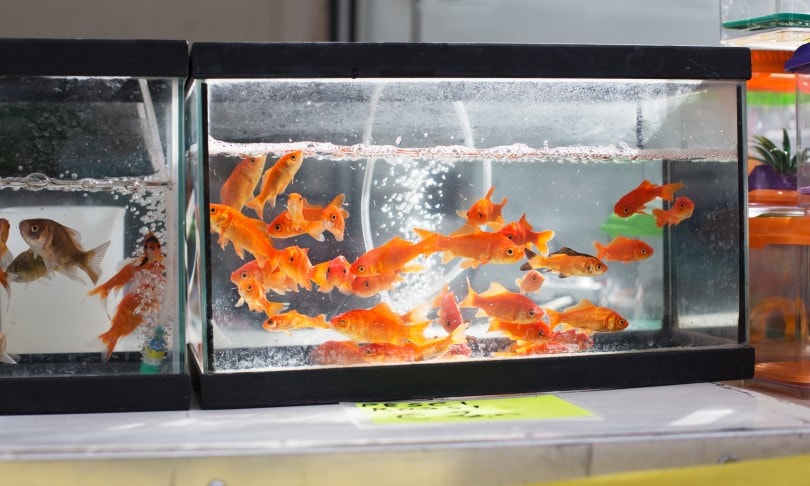
These fish do exceptionally well with other goldfish and others with a calm temperament. They tend to pair well with fish such as:
However, if you have a rowdy crowd, you might want to stay away. Here are some incompatible mates:
If you have any questionable existing fish, always look up compatibility before purchasing to avoid bullying.
What to Feed Your Pompom Goldfish
It might surprise some that fish pellets aren’t all that’s necessary to keep up with your goldfish’s dietary needs. Sure, those pellets are the primary base for nutrition, but that’s not all.
Like other goldfish, Pompom Goldfish are omnivorous, meaning they need both plant and animal-based matter to survive healthily.
So, offering fresh fruits, vegetables, and insects to fortify their diet is a terrific idea to keep them chubby, healthy, and perfectly colored.
Here are some goldfish-friendly snacks to consider:
Goldfish are notorious eaters and can easily consume too much. Don’t give in to their begs at the edge of the glass, beckoning you over for a little snack. They need appropriately measured meals to avoid overeating, which can lead to bigger health issues.

Keeping Your Pompom Goldfish Healthy
Goldfish can be susceptible to several ailments due to genetic issues, poor tank environment, and other factors. Making sure your goldfish has the right diet, appropriate tank mates, and a suitable setting is the primary concern.
Making sure your Pompom is healthy involves direct supervision and observation of the tank conditions and how they get along with others.
If you notice your goldfish is looking a little unhealthy or seems to have changed in normal behavior, you might need to dig deeper. Seeking advice from an exotic vet or doing research can point you in the right direction for a solution.
It’s important to also note that Pompoms are not aggressive eaters. They are very lackadaisical fish that meander around the tank at their speed. So, it’s imperative that they get equal shares of the food distribution.
Don’t let another fish bully your Pompom. If you notice a lack of color, lackluster appearance, or decreased activity, take note of environmental changes that might spark this change.
Common Ailments for Pompom Goldfish
Goldfish can fall victim to several health ailments, so it’s essential to keep the tank clean and free of debris and bacteria.
Here are a few issues that can crop up among others:
Keeping the environment clean, offering a proper diet, and getting compatible tank mates are all aspects of their health.
A healthy Pompom Goldfish with no serious health issues can live up to 15 years or longer in captivity.
Breeding
If you want to try your hand at breeding or just want to know the risk for unintended reproduction among your fish—we have the breeding answers for you.
Pompoms have been around for years now with successful breeding being the critical element in breed conservation. Even though they aren’t as popular as in previous years, they’re still top-notch candidates for breeding.
Not only can you reproduce with ease, but these fancy goldfish can also make you a pretty penny on the side if you choose to breed. However, if you do breed, ensure you’re doing so responsibly.
Proper Breeding Measures
To start, you need to ensure the water is at a suitable temperature. While Pompoms enjoy water up to 80 degrees in some cases, this isn’t an optimal range for breeding—the lower end of the scale, the better.
Most aquarists with any luck breeding these fish recommend keeping conditions at a solid 68-degrees. It provides the right breeding environment without overheating the mating pair or eggs.
You can put the spawning pair together for fertilization, but once the eggs come, it’s time to separate the parents. You might find eggs stuck to plants and other materials in the tank.
Keeping the eggs at a modest 68-degrees the entire time provides an optimal environment where they can thrive without getting too hot. Temperatures that exceed 68-degrees can cause a lack of success when hatching or spawning.
However, we should note that during breeding season, the Pompom female can mimic the appearance of a male to avoid breeding. So, it can be hard to tell them apart. Also, it’s not unusual for pairings to be unsuccessful in the first few attempts.
But if you keep water conditions and rations right, they will eventually reproduce as a pair. Hatchlings emerge from eggs within three to five days. One female can lay between 200 and 1,000 eggs per clutch, so be prepared for a tank full of tiny swimmers.
Are Pompom Goldfish Suitable For Your Aquarium?
Pompoms are wonderfully sweet fish to add to any relaxed aquarium setting. While they might not charm you with their zippy swimming patterns or keen intelligence, they are beautiful and docile creatures with plenty to offer.
Keeping or breeding Pompoms isn’t a difficult task, although you do have to make sure to provide proper living conditions. Pompoms don’t pair well in intense water filtration systems or high temperatures.
Remember, only keep Pompoms with other calm, friendly tank mates to avoid bullying. If you keep up with routine care and provide the right tank space, you’ll love your Pompom Goldfish.
Other Goldfish Reads:
- Imperial Goldfish
- Can Goldfish Eat Tropical Fish Flakes? The Answer Explained
- Constipation & Indigestion in Goldfish: Symptoms, Treatment & Prevention
- Best Goldfish Books Every Aquarist Should Read
Featured Image Credit: Ek Ing, Shutterstock


